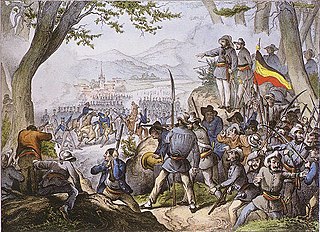
Joseph Freiherr von Hammer-Purgstall was an Austrian orientalist, historian and diplomat. He is considered one of the most accomplished orientalists of his time.

The Battle of Sisak was fought on 22 June 1593 between Ottoman Bosnian forces and a combined Christian army from the Habsburg lands, mainly the Kingdom of Croatia and Inner Austria. The battle took place at Sisak, central Croatia, at the confluence of the Sava and Kupa rivers, on the borderland between Christian Europe and the Ottoman Empire.
Paulus Stephanus Cassel, born Selig Cassel, was a German Jewish convert to Christianity, writer, orator, and missionary to Jews.

Fortunato Santini was an Italian priest, composer and music collector.

Lorenz von Westenrieder was a well-known author and historian in Bavaria and a critic of the Elector Karl Theordor and supporter of Maximilian IV Joseph. There are several memorials to him in Munich.

The Ottoman–Venetian peace treaty of 1419 was signed between the Ottoman Empire and Republic of Venice, ending a short conflict between the two powers, confirming Venetian possessions in the Aegean Sea and the Balkans, and stipulating the rules of maritime trade between them.

Michael Hahn was a German Pietist, Theosophist and the founder of the Hahn'schen Gemeinschaft. His alleged forename Johann does not appear on his birth certificate.
Yavuz Ali Pasha or Malkoç Ali Pasha was an Ottoman statesman. He belonged to the Malkoçoğlu family and served as the Grand Vizier of the Ottoman Empire from 16 October 1603 to 26 July 1604 replacing Yemişçi Hasan Pasha. He had previously served as the Ottoman governor of Egypt from 1601 to 1603. His installation as Grand Vizier took place on 29 December 1603, over two months after his appointment and a week after the accession of Ahmed I, due to the time it took him to settle affairs in Egypt and travel to Constantinople. He brought with him two years' worth of the province's back taxes.
Andreas von Auersperg, Lord of Schönberg und Seisenberg was a Carniolan noble from the influential Auersperg family, leader of the defending forces at the Battle of Sisak in 1593.

Weilheim in Oberbayern is a town in Germany, the capital of the district Weilheim-Schongau in the south of Bavaria. Weilheim has an old city-wall, historic houses and a museum.
Heinz Schilling is a German historian.

The Soest Feud, or Feud of Soest, was a feud that took place from 1444 to 1449 in which the town of Soest claimed its freedom from Archbishop Dietrich of Cologne (1414–1463), who tried to restore his rule. The town of Soest opposed this attempt on 5 June 1444 by accepting a new suzerain, John I, the Duke of Cleves-Mark, who guaranteed the town its old rights as well as new ones. As a result Emperor Frederick III imposed the imperial ban on the town. The victory of the town meant that Soest had de facto more freedom than a free imperial city until it was annexed by Prussia, but at the same time it had to forfeit its economic power because it was now an enclave within Cologne's territory.

The Battle on the Scheideck, also known as the Battle of Kandern took place on 20 April 1848 during the Baden Revolution on the Scheideck Pass southeast of Kandern in south Baden in what is now southwest Germany. Friedrich Hecker's Baden band of revolutionaries encountered troops of the German Confederation under the command of General Friedrich von Gagern. After several negotiations and some skirmishing a short battle ensued on the Scheideck, in which von Gagern fell and the rebels were scattered. The German Federal Army took up the pursuit and dispersed a second revolutionary force that same day under the leadership of Joseph Weißhaar. The Battle on the Scheideck was the end of the road for the two rebel forces. After the battle, there were disputes over the circumstances of von Gagern's death.
Michael Doeberl was a German historian who specialized in Bavarian history.

Bernhard Erdmannsdörffer was a German historian. He was the father of mineralogist Otto Erdmannsdörffer.
Islamkundliche Untersuchungen is a series of scholarly publications in the field of Islamic studies issued by the Klaus Schwarz Verlag of Berlin, Germany. Most of the texts are in German, with some in English, French or other languages.
Leca or Lecca of Cătun, also known as Leca of Leurdeni, Leca Rudeanu, Comisul Leca, or Postelnico Leka, was a Wallachian political figure, prominent under Princes Michael the Brave, Radu Șerban, and Radu Mihnea. Originally a Comis, his first major assignments came during Prince Michael's conquest of Transylvania, when he also submitted to, and fought for, the Holy Roman Empire. Leca was a commander of Wallachian troops in Michael's battles at Mirăslău (1600) and Guruslău (1601), returning to Wallachia after Michael's assassination.
Sieghard Brandenburg was a German musicologist, who stood out especially as a Beethoven researcher.

The County of Steinfurt, originally the Lordship of Steinfurt, was a historic territory of the Holy Roman Empire in the Münsterland. It existed from roughly 1100 until 1806.

The siege of Esztergom was a military conflict on August 16, 1685, between the armies of the Holy Roman Empire, particularly Imperial Austrian troops, and the Ottoman Empire during the Great Turkish War. The siege near today's town of Esztergom ended in defeat for the Ottomans.











